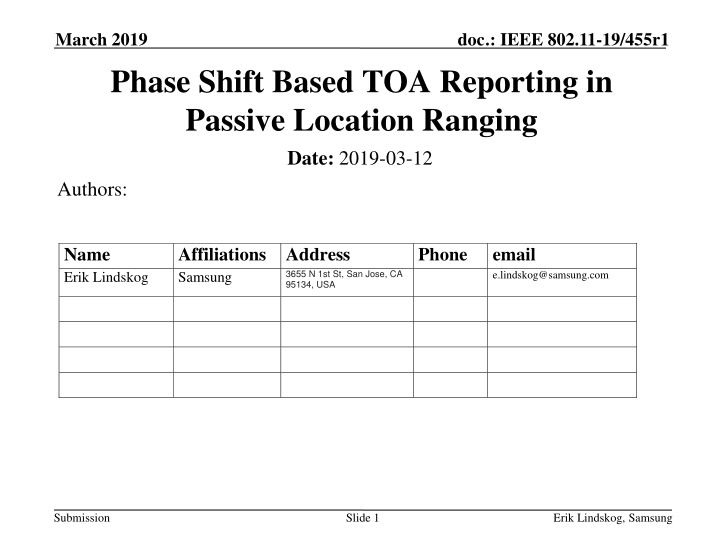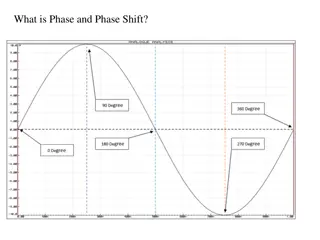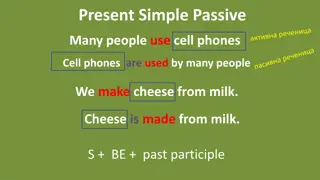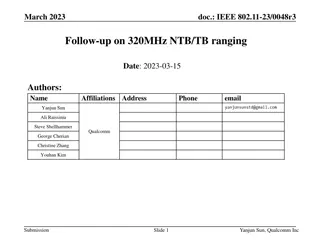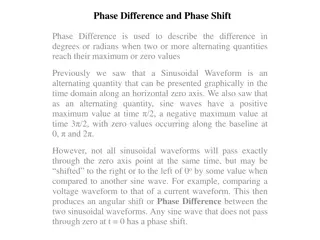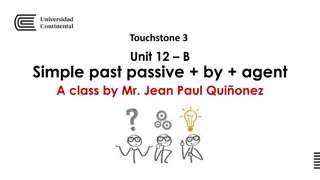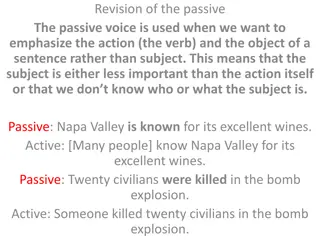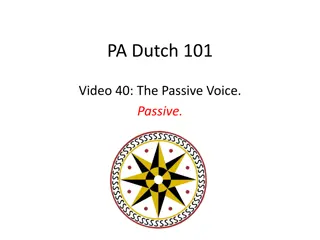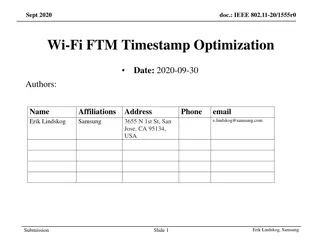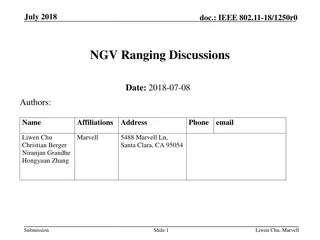Passive Location Ranging Using Phase Shift Based TOA Reporting
This document discusses the implementation of phase shift based time-of-arrival (TOA) reporting in passive location ranging within the IEEE 802.11 standard. The proposal suggests enabling this feature for passive ranging alongside existing active ranging methods, aiming to enhance accuracy and reliability. The protocol addition comprises a 1-bit addition to facilitate the reporting of TOA measurements. Various elements of the passive location measurement report and broadcast frames are detailed, highlighting the importance of adding new types to timestamp fields for improved ranging calculations.
Download Presentation

Please find below an Image/Link to download the presentation.
The content on the website is provided AS IS for your information and personal use only. It may not be sold, licensed, or shared on other websites without obtaining consent from the author.If you encounter any issues during the download, it is possible that the publisher has removed the file from their server.
You are allowed to download the files provided on this website for personal or commercial use, subject to the condition that they are used lawfully. All files are the property of their respective owners.
The content on the website is provided AS IS for your information and personal use only. It may not be sold, licensed, or shared on other websites without obtaining consent from the author.
E N D
Presentation Transcript
March 2019 doc.: IEEE 802.11-19/455r1 Phase Shift Based TOA Reporting in Passive Location Ranging Date: 2019-03-12 Authors: Name Erik Lindskog Affiliations Address Samsung Phone email e.lindskog@samsung.com 3655 N 1st St, San Jose, CA 95134, USA Submission Slide 1 Erik Lindskog, Samsung
March 2019 doc.: IEEE 802.11-19/455r1 CIDs addressed This submission addresses the TGaz LB 240 CIDs 1515, 1557 and 1563. Submission Slide 2 Erik Lindskog, Samsung
March 2019 doc.: IEEE 802.11-19/455r1 Background We now have the option to use phase shift based TOA reporting in TB Ranging. There is no reason why we should not also enable this for the Passive Location Ranging case. What is needed is some enabling in the time-stamp reporting. Submission Slide 3 Erik Lindskog, Samsung
March 2019 doc.: IEEE 802.11-19/455r1 Proposed Protocol Addition: 1 bit Submission Slide 4 Erik Lindskog, Samsung
March 2019 doc.: IEEE 802.11-19/455r1 Passive Location ISTA to RSTA LMR ISTA Passive Location Measurement Report Element : Dialog Token, CFO to Responder, N Time Stamps, etc. Per time-stamp Time Stamp Measurement Report field : Type TOD TOA PS-TOA Correction to peer STA PS-TOA Valid Time-Stamp Time-Stamp Error RID (of transmitter) Add a bit to add two new types. Submission Slide 5 Erik Lindskog, Samsung
March 2019 doc.: IEEE 802.11-19/455r1 Primus RSTA Broadcast Frame LCI table, optional RSTA Passive Location LMR: Dialog Token, CFO to Responder, N Time Stamps, etc. Per time-stamp Time Stamp Measurement Report field : Type TOD TOA PS-TOA Correction to peer STA PS-TOA Valid Time-Stamp Time-Stamp Error RID (of transmitter) Add a bit to add two new types. Submission Slide 6 Erik Lindskog, Samsung
March 2019 doc.: IEEE 802.11-19/455r1 Secundus RSTA Broadcast Frame Per ISTA - ISTA Passive Location Measurement Report Element : Dialog Token, CFO to Responder, N Time Stamps, etc. Per time-stamp Time Stamp Measurement Report field : Type TOD TOA PS-TOA Correction to peer STA PS-TOA Valid Time-Stamp Time-Stamp Error RID (of transmitter) Add a bit to add two new types. Copy of the LMR report from each ISTA Submission Slide 7 Erik Lindskog, Samsung
March 2019 doc.: IEEE 802.11-19/455r1 Range and DTOA Calculations Submission Slide 8 Erik Lindskog, Samsung
March 2019 doc.: IEEE 802.11-19/455r1 ISTA to RSTA Range Calculations Ranging NDP transmissions and time stamps ISTA RSTA UL NDP t1 t2 DL NDP t3 t4 The differential distance from the ISTA to the RSTA can then be calculated as [1]: D_IR = [(t2 - t1) + (t4 t3)]/2 * c ,where the time stamps are as shown above and c is the speed of light. Submission Slide 9 Erik Lindskog, Samsung
March 2019 doc.: IEEE 802.11-19/455r1 Propagation paths and time stamps Ranging NDP transmissions and time stamps PSTA ISTA RSTA t1 UL MU NDP t2 t5 DL NDP t3 t4 t6 The differential distance between the PSTA and the RSTA vs. the ISTA can now be calculated as [2]: DD_PIR = [t6 t3 (t5 t1)]*c = [t6 t3 (t5 (t2-T_IR))]*c = [t6 t5 t3 + t2 - T_IR] * c Using T_IR = [(t4 t1) (t3 t2)]/2 We get: DD_PIR = [t6 t5 t3 + t2 - 0.5*t4 + 0.5*t1 + 0.5*t3 - 0.5*t2)]*c Or: DD_PIR = [t6 t5 0.5*t3 + 0.5*t2 0.5*t4 + 0.5*t1]*c Submission Slide 10 Erik Lindskog, Samsung
March 2019 doc.: IEEE 802.11-19/455r1 Distance Calculations - ISTA, i.e. t4, PS-TOA Distance calculations: Assume t4 is measured with PS-TOA. According to our earlier calculations, the distance between ISTA and RSTA is: D_IR = [(t2 - t1) + (t4 t3)]/2 * c When using PS-TOA for t4, t4 will be too large. To make the above calculation work out the responder can compensate by can either decrease t2 or increase t3. Likewise the differential distance from PSTA to ISTA-RSTA pair is: DD_PIR = [t6-t5_1-0.5*t3+0.5*t2-0.5*t4_1+0.5*t1_1]*c Again, when using PS-TOA for t4, t4 will be too large. Here to make this calculation work out, the responder can compensate by either increase t2 or decrease t3. Thus, the RSTA cannot adjust its reported time stamps, t2 and t3, such as to make both the D_IR and the DD_PIR calculations work out. If t2 is measured with PS-TOA by the RSTA, then the corresponding problem occurs. => Need to report the correction to the PS-TOA separately! Submission Slide 11 Erik Lindskog, Samsung
March 2019 doc.: IEEE 802.11-19/455r1 ISTAs Reporting PS-TOAs Submission Slide 12 Erik Lindskog, Samsung
March 2019 doc.: IEEE 802.11-19/455r1 Passive Location with Phase Shift Based TOA Reporting - ISTA reporting PS-TOA Correction to PS-TOA calculated RSTA PS-TOA reported PS-TOA and correction broadcasted ISTA Measures PS-TOA Passive Station (PSTA) Erik Lindskog, Samsung Submission Slide 13
March 2019 doc.: IEEE 802.11-19/455r1 Passive Location Ranging with PS-TOA ISTA reporting PS-TOA Primus and Secundus LCI/LMR broadcasting frames Calculation of (last) ISTA s PS-TOA correction and reporting in the Primus broadcast frame. rSTA to iSTA LMR LCI, DL LMR iSTA to rSTA LMR TF UL NDP TF UL LMR UL NDP TF Poll TF DL DL NDP NDPA RSTA iSTA to rSTA LMR UL NDP PR ISTA 1 iSTA to rSTA LMR UL NDP PR ISTA 2 ISTA reports PR-TOAs - Indicates PS-TOA feedback RSTA reports correctio ns to the ISTAs PS-TOAs Re- broad- casting ISTA LMR reports RSTA starts computing the PS-TOA correction for the last ISTA ISTAs measures PS-TOAs Submission Slide 14 Erik Lindskog, Samsung
March 2019 doc.: IEEE 802.11-19/455r1 PS-TOA Reporting in ISTA to ISTA Ranging PS-TOA correction reported PS-TOA correction calculated RSTA ISTA 1 PS-TOA and correction broadcasted PS-TOA reported ISTA 2 Measures PS-TOA Passive Station (PSTA) If an ISTA is reporting PS-TOAs, then it can still range with other ISTAs in the Passive Location Ranging exchange, as long as these other ISTAs are able to calculate the correction. Submission Slide 15 Erik Lindskog, Samsung
March 2019 doc.: IEEE 802.11-19/455r1 ISTA PS-TOA Reporting Benefits in Passive Location Ranging Enables simple design of passive location ISTAs Simplifies immediate feedback for ISTAs The PS-TOA more or less already calculated in the PHY - Immediate ISTA feedback greatly simplified. A powerful enough RSTA would be capable to immediately turn around and broadcast the corrections to the ISTAs PS-TOAs Enables immediate feedback of all time-stamps. Also enables ISTA to ISTA ranging with PS-TOA reporting. Submission Slide 16 Erik Lindskog, Samsung
March 2019 doc.: IEEE 802.11-19/455r1 RSTA Reporting PS-TOAs Submission Slide 17 Erik Lindskog, Samsung
March 2019 doc.: IEEE 802.11-19/455r1 Passive Location with Phase Shift Based TOA Reporting - RSTA reporting PS-TOA Measures PS-TOA RSTA PS-TOA reported PS-TOA and correction broadcasted Correction to PS-TOA calculated ISTA Correction PS-TOA reported Passive Station (PSTA) Submission Slide 18 Erik Lindskog, Samsung
March 2019 doc.: IEEE 802.11-19/455r1 Primus and Secundus LCI/LMR broadcasting frames Passive Location Ranging with PS-TOA RSTA reporting PS-TOA rSTA to iSTA LMR LCI, DL LMR iSTA to rSTA LMR TF UL NDP TF UL LMR UL NDP TF Poll TF DL DL NDP RSTA NDPA RSTA PS-TOAs - Indicate PS- TOA feedback iSTA to rSTA LMR UL NDP PR ISTA 1 iSTA to rSTA LMR UL NDP PR ISTA 2 Re- broad- casting ISTA the LMR reports Broad- cast of RSTA TODs and PS- TOAs PS-TOA corrections reported ISTAs calculates the corrections to the RSTA s s PS-TOAs Submission Slide 19 Erik Lindskog, Samsung
March 2019 doc.: IEEE 802.11-19/455r1 RSTA PS-TOA Reporting Benefits in Passive Location Ranging Offloads RSTA processing Makes use of possibly available processing resources at the ISTAs Submission Slide 20 Erik Lindskog, Samsung
March 2019 doc.: IEEE 802.11-19/455r1 Straw Poll Submission Slide 21 Erik Lindskog, Samsung
March 2019 doc.: IEEE 802.11-19/455r1 Straw Poll Do you support to add a bit to Passive Location Ranging time-stamp stamp type to get two new time-stamp types: PS-TOA Correction to peer PS-TOA time stamp as shown in slides 5-7, and use it to report PS-TOAs and corrections to peer PS-TOAs? Y: N: A: Submission Slide 22 Erik Lindskog, Samsung
March 2019 doc.: IEEE 802.11-19/455r1 References [1] Passive Location , IEEE 802.11-17/0417r0. [2] CIDs 46,47,48 Regarding Fine Timing Measurement , 11-12/1249r4, Carlos Aldana (Qualcomm) et al. Submission Slide 23 Erik Lindskog, Samsung
March 2019 doc.: IEEE 802.11-19/455r1 Thank You! Submission Slide 24 Erik Lindskog, Samsung
